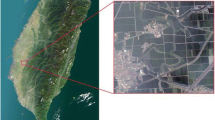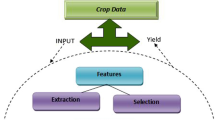Abstract
Paddy rice is the major crop of food in Taiwan. There are three main contributions of rice cultivation on Taiwan: regional eco-friendly of environments, adjustment of floods, and refreshing the air. The estimation of paddy rice crop area is important since this information is related to the national food policy, yearly crop yields calculation, and post-disaster reimbursement. In the past, a large amount of human power and time-consuming works are performed through field exploration and rice pattern revising. A more economic manner to estimate paddy rice area is desired. Accordingly, this study aims to design a paddy rice classifier by which the evaluation of paddy rice area in a remote sensing image can be rationally performed. In this study, the ant-based clustering optimization (ACO) algorithm is used to present image classification on paddy rice mapping. The advantage of this algorithm is that it can effectively cluster data into groups through unsupervised learning. The ACO implementation can be organized to the following steps: (a) initialize the number of ants, (b) compute the pheromone trail matrix of ants, (c) update the pheromone trail matrix, (d) select the best few ants that have the optimal object function value, and (e) repeat iterations until termination criteria are satisfied. In the meantime, self-organizing map (SOM) clustering was used as a parallel study for comparison. A classifier for paddy rice pattern discernment was built as well as paddy rice thematic maps are drawn. The result shows that ACO clustering algorithm has a higher accuracy than that of SOM.







Similar content being viewed by others
References
Baraldi A, Parmiggiani F (1995) A neural network for unsupervised categorization of multivalued input patterns: an application to satellite image clustering. Geosci Remote Sens IEEE Trans 33(2):305–316
Bastin L (1997) Comparison of fuzzy C-means classification, linear mixture modeling and ML C probabilities as tool for unmixing coarse pixels. Int J Remote Sens 18(17):3629–3648
Chauhan MK, Agarwal A (2008) Estimating land cover class area from remote sensing classification. J Appl Remote Sens 2(1):023514
Dorigo M, Stützle T (2005) Ant colony optimization. Prentice Hall, New Delhi
Ella L, van den Bergh F, van Wyk BJ, van Wyk MA (2008) A comparison of texture feature algorithms for urban settlement classification, IGARSS 2008. IEEE Int Geosci Remote Sens Sym 3:1308–1311
Gambardella LM, Dorigo M (2000) INFORMS J. Comput 12:237–255
Handl J, Meyer B (2007) Ant-based and swarm-based clustering. Swarm Intell 1:195–113
Kirshnaiash PR, Kanal LN (1982) Classification, pattern recognition, and reduction of dimensionality, vol. 2 of Handbook of Statistics. North-Holland, Amsterdam
Kohonen T (1982) Self-organized formation of topologically correct feature maps. Biol Cybern 43(1):59–69
Kohonen T (2001) Self-organizing maps, 3rd edn. Springer, Berlin
Lei TC, Chou TY, Cheng TY (2007) Classification of vegetation cover using semivariogram texture information on Quickbird image. J Photogramme Remote Sens 12(1):1–16 (in Chinese)
Lei TC, Wan S, Chou TY (2008) The comparison of PCA and discrete rough set for feature extraction of remote sensing image classification—a case study on rice classification, Taiwan. Comput Geosci 12(1):1–14
Lillesand T, Kiefer RW, Chipman J (2008) Remote sensing and image interpretation, 6th edn. Wiley, New York
Matsakis P, Andrefouet S, Capolsini P (2000) Evaluation of fuzzy partitions. Remote Sens Environ 74:516–533
Miranda FP, Macdonald JA, Carr JR (1992) Application of the semivariogram textural classifier (STC) for vegetation discrimination using SIR-B data of Borneo. Int J Remote Sens 13(12):2349–2354
Mohan BC, Baskaran R (2012) Review: a survey: ant colony optimization based recent research and implementation on several engineering domain. Expert Syst Appl 39(4):4618–4627
Pal M, Mather PM (2003) An assessment of the effectiveness of decision tree methods for land cover classification. Remote Sens Environ 86:554–565
Pradhan B (2013) A comparative study on the predictive ability of the decision tree, support vector machine and neuro-fuzzy models in landslide susceptibility mapping using GIS. Comp Geosci 51:350–365
Pradhan B, Lee S (2010) Landslide susceptibility assessment and factor effect analysis: back propagation artificial neural networks and their comparison with frequency ratio and bivariate logistic regression modelling. Environ Model Softw 25(6):747–759
Pradhan B, Mansor S, Pirasteh S, Buchroithner M (2011) Landslide hazard and risk analyses at a landslide prone catchment area using statistical based geospatial model. Int J Remote Sens 32(14):4075–4087
Pradhan B, Chaudhari A, Adinarayana J, Buchroithner MF (2012) Soil erosion assessment and its correlation with landslide events using remote sensing data and GIS: a case study at Penang Island, Malaysia. Environ Monit Assess 184(2):715–727
Shelokar PS, Jayaraman VK, Kulkarni BD (2004) An ant colony approach for clustering. Anal Chim Acta 509:187–195
Stützle T, Hoos H (1997) The MAX-MIN ant system and local search for the traveling salesman problem. IEEE Conf Evol Comp (ICEC’97), 309–314
Theodoridis S, Koutroumbas K (2008) Pattern recognition. Elsevier Science, Amsterdam. ISBN 1597492728
Wan S, Chang SH (2014) Combined particle swarm optimization and linear discriminant analysis for landslide image classification: application to a case study in Taiwan. Environ Earth Sci. doi:10.1007/s12665-014-3050-y
Wan S, Lei TC, Chou TY (2010) An enhanced supervised spatial decision support system of image classification: consideration on the ancillary information of paddy rice area. Int J Geograph Info Sci 24(4):623–642
Woodcock CE, Strahler AH, Jupp DLB (1988) The use of variograms in remote sensing. Remote Sens Environ 25:323–348
Youssef AM, Pradhan B, Maerz NH (2014) Debris flow impact assessment caused by 14 April 2012 rainfall along the Al-Hada Highway, Kingdom of Saudi Arabia using high resolution satellite imagery. Arab J Geosci 7:2591–2601
Author information
Authors and Affiliations
Corresponding author
Rights and permissions
About this article
Cite this article
Chang, SH., Wan, S. A novel study on ant-based clustering for paddy rice image classification. Arab J Geosci 8, 6305–6316 (2015). https://doi.org/10.1007/s12517-014-1617-2
Received:
Accepted:
Published:
Issue Date:
DOI: https://doi.org/10.1007/s12517-014-1617-2




